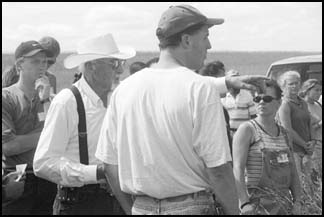 A lifetime of conservation on a farm north of Paynesville was on display last week as a model of conservation.
A lifetime of conservation on a farm north of Paynesville was on display last week as a model of conservation.Harold Manz (left with white hat) has been planting trees and making ponds for over 50 years on his 300-acre farm a couple miles north of Paynesville. He had the opportunity to show his efforts to a group of about 30 new employees of the Natural Resource Conservation Service (NRCS), who were on a tour of conservation projects in the Paynesville area.
"It was a privilege to talk to those people," said Manz. "Anything that's a privilege you enjoy."
The new employees, all of whom have worked for the NRCS for less than a year, came from around the country. All of them were taking part in the Skills Enhancement Training for the NRCS. They were housed at St. Cloud State University for two weeks for the training, nicknamed boot camp by the NRCS. Steve Sellnow, district conservationist at the St. Cloud office of the NRCS, organized a three-day farm tour in Stearns County, from July 19-21, including the stops in Paynesville on Monday.
Starting over 50 years ago, Manz has now planted over 30,000 trees on his property. "Prior to that, there weren't many trees besides the windbreak," he said. Now he has volunteer trees growing on his farm, second generation trees whose forebearers he planted years ago.
"I planted a mixture of trees, mostly evergreen species," added Manz. He also planted some hardwood trees, especially elms and maples.
His approach to planting is to try a little of everything. He would plant a variety of grasses, too. That way "something would take," he explained.
At one spot on his farm, he jokingly told the NRCS employees that he planted trees there because it was too rocky for crops. "It's true," he said. "I picked a lot of rocks off the ridges, so I put trees there instead."
In the 1980s, Manz lost 2,000 trees to a drought.
Ten years ago, Manz put half of his farm in the Conservation Reserve Program. This spring, he put it all in the program, which pays farmers to restore natural vegetation instead of planting crops.
"We're mainly concerned about water conservation on this farm," said Manz. His purpose is to hold the water on the farm so it doesn't flow into the Mississippi. A creek on his farm flows into the North Fork of the Crow River, which flows into the Mississippi River near Rogers.
Manz's farm has 14 ponds, including one main pond. He used terracing for most of the ponds and had help from some beavers on a few others. If he holds the water on his farm, that prevents someone downstream from dealing with it.
On the edges of some ponds are hook and looper inlets. When the water in the ponds gets high enough, water flows from the inlet to the creek, but very gently.
"Harold has been a real active conservationist for over 40 years, probably closer to 50 years," said Sellnow, who noted that Manz was recognized with an outstanding conservationist award 10 years ago. Sellnow said the Manz farm was nice for the tour because it has so many aspects of conservation to show the trainees. "They were impressed with Harold," Sellnow added. "He's been a special conservationist."
"I contribute my success and privilege to my Maker; my wife, Joyce, of the past; my sons, Woody and Burton, and my daughter, Beverly; and to all my good neighbors and friends," said Manz. He also appreciates all the help he has gotten from government agencies like the NRCS and the Department of Natural Resources and their employees.
He also thanked the Paynesville Sportmen's Club, which has released pheasants near his farm and has provided feed that he has used in the winter.
"Wildlife just has a ball here," Manz said. "Dozens and dozens of ducks hatch here. Deer come to visit this farm very often."
The NRCS employees toured conservation projects for three days last week. While in Paynesville on Monday, they also visited a streambank stabilization project on the Gerald Kennedy farm and a liquid manure storage pit and feedlot run-off control project on the Richard Pflueger farm.